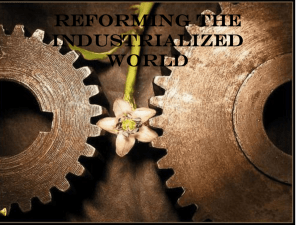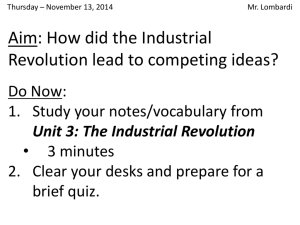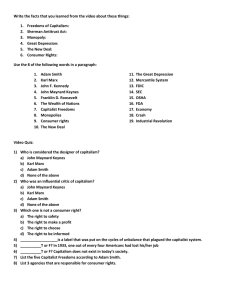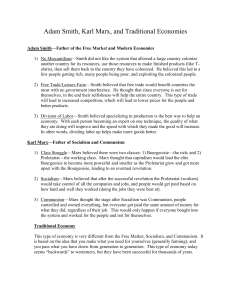(a) and (b).
advertisement
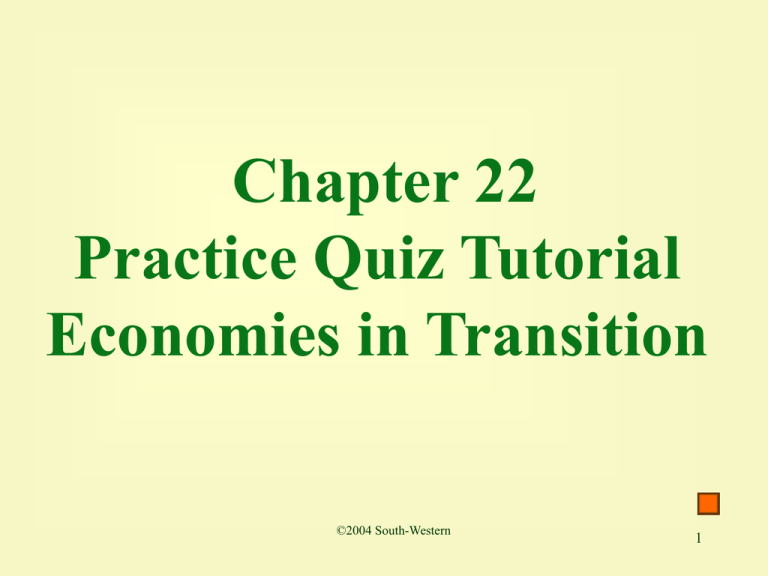
Chapter 22 Practice Quiz Tutorial Economies in Transition ©2004 South-Western 1 1. The economic system in which all of the basic decisions are made through a centralized authority, such as a government agency, is termed a a. market economy. b. capitalistic economy. c. command economy. d. traditional economy. C. To answer the three basic economic questions, the market economy uses the price system and a traditional economy is based on customs. 2 2. Command economies typically suffer from a. unemployment, but not underemployment. b. neither unemployment nor underemployment. c. both unemployment and underemployment. d. underemployment, but not unemployment. D. Command economies assign people jobs rather than allow the market system to determine wages and employment. 3 3. Adam Smith stated that the only role of government in society should be to a. provide defense. b. enforce contracts. c. do absolutely nothing. d. both (a) and (b). D. Adam Smith believed in a limited role of the government to provide national defense, education, maintain infrastructure, enforce contracts, and little else. 4 4. When making economic decisions, Adam Smith urged society to a. follow the principle of self-interest. b. follow the principle of public interest. c. transfer wealth according to need. d. provide equal income for all citizens. A. Adam Smith stated “By pursuing his own interest he frequently promotes that of the society more effectively than when he really intends to promote it.” 5 5. The doctrine of laissez faire a. advocates an economic system with extensive government intervention and little individual decision-making. b. was advocated by Adam Smith in his book The Wealth of Nations. c. was advocated by Karl Marx in his book Das Kapital. d. is described by none of the above. B. Laissez faire is a French expression meaning “allow them to act” stated differently, “The least government is the best government.” 6 6. In Adam Smith’s competitive market economy, the question of what goods to produce is determined by the a. “invisible hand” of the price system. b. “invisible hand” of government. c. “visible hand” of public interest. d. “visible hand” of laws and regulations. A. The “invisible hand” refers to a system where no central authority makes the key economic decisions, but rather decisions are made collectively by all consumers and producers in the economy. 7 7. Adam Smith wrote that the a. economic problems of the 18th-century England were caused by free markets. b. government should control the economy with an “invisible hand.” c. pursuit of private self-interest promotes the public interest in a market economy. d. public or collective interest is not promoted by people pursuing their self-interest. C. Adam Smith recognized that everyone making decisions based on their own self interest would enhance the public interest. 8 8. Adam Smith, in his book The Wealth of Nations, advocated a. socialism. b. an economy guided by an “invisible hand.” c. government control of the “invisible hand.” d. the adoption of mercantilism. B. Adam Smith advocated a laissez faire stance by government. That is, the government should provide the foundation for a free market system, but should not be a major participant in answering the questions of What, How, and for Whom. 9 9. The economic system in which private individuals own the factors of production is a. a planned economy. b. capitalism. c. collectivism. d. socialism. B. For answers a,c, d, resources or factors of production are owned by the government. 10 10. Which of the following is not a basic characteristic of capitalism? a. Economic decisions occur in markets. b. Factors of production are privately owned. c. Income is distributed on the basis of need. d. Businesses make their own product and price decisions. C. Karl Marx believed people would be motivated by the principle “from each according to his ability, to each according to his need.” 11 11. According to Karl Marx, under capitalism, a. profits would be shared fairly. b. incomes would be distributed equally. c. workers would be exploited and revolt against owners of capital. d. workers would actually own the factors of production. C. Karl Marx believed that private ownership and profits lead to exploitation. The result is a class struggle between a few “haves” and “have nots.” 12 12. Karl Marx predicted which of the following? a. market system would self destruct. b. “haves” would revolt against the “havenots.” c. wealthy were entitled to profits as their reward for risk-taking. d. none of the above. A. Karl Marx argued the market system would destroy itself because owners would go too far and pay starvation wages in order to maximize profits. 13 13. How many nations in the world today operate totally according to Karl Marx’s theory of communism? a. None. b. Several. c. Only the United States. d. Many. A. Under Marx’s idealized society of communism, people would distribute wealth according to need and no central authority would be necessary. 14 14. In Marx’s ideal communist society, the state a. actively promotes income equality. b. follows the doctrine of laissez faire. c. owns resources and conducts planning. d. does not exist. D. Under Marx’s idealized society of communism, individuals with ability and not the government would distribute the wealth of society according to each person’s need. 15 15. Karl Marx was a (an) a. 19th-century German philosopher. b. 18th-century Russian economist. c. 14th-century Polish banker. d. 19th-century Russian journalist. A. Karl Marx was born in Germany, the son of a lawyer. Marx was an outstanding student at Berlin University. In 1841, after receiving a doctorate in philosophy, he turned to journalism. 16 END 17

